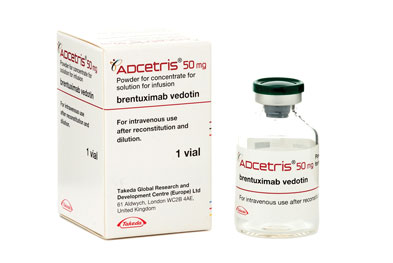
"Today's approval represents an improvement in the initial treatment regimens of advanced Hodgkin lymphoma that were introduced into clinical practice more than 40 years ago," said Richard Pazdur, M.D., director of the FDA's Oncology Center of Excellence and acting director of the Office of Hematology and Oncology Products in the FDA's Center for Drug Evaluation and Research. "This approval demonstrates our commitment to approving advancements in treatment that give prescribers and patients different options for care."
Lymphoma is a cancer that begins in the lymph system, which is part of the immune system that helps the body fight infection and disease. Lymphoma can begin almost anywhere in the body and can spread to nearby lymph nodes. The two main types of lymphoma are Hodgkin lymphoma (also called Hodgkin disease) and non-Hodgkin lymphoma. Most people with Hodgkin lymphoma have the classical type. With this type, there are large, abnormal lymphocytes (a type of white blood cell) in the lymph nodes called Reed-Sternberg cells. With early intervention, patients with Hodgkin lymphoma can usually experience long-term remission.
The National Cancer Institute at the National Institutes of Health estimates that 8,260 people in the United States were diagnosed with Hodgkin lymphoma last year and approximately 1,070 patients with non-Hodgkin lymphoma died from the disease in 2017.
Adcetris combines an antibody and drug, allowing the antibody to direct the drug to a target on lymphoma cells known as CD30. Adcetris has also been previously approved by the FDA to treat cHL after relapse, cHL after stem cell transplant when a patient is at a high risk of relapse or progression, systemic anaplastic large cell lymphoma (ALCL) after failure of other treatment, and primary cutaneous ALCL after failure of other treatment.
The approval for adult patients with previously untreated stage III or IV cHL was based on a clinical trial comparing Adcetris plus chemotherapy (Adriamycin [doxorubicin], vinblastine and dacarbazine, or AVD) to a chemotherapy-only regimen common for cHL treatment (AVD plus bleomycin, also known as ABVD). The trial measured modified progression-free survival (mPFS), which considers the length of time it took for the disease to progress, death to occur, or new therapy to be initiated in patients who did not achieve a complete response. In the trial of 1,334 patients, after patients received an average of six 28-day cycles of treatment, those treated with Adcetris plus AVD were 23 percent less likely to experience progression, death, or initiation of new therapy compared with those receiving ABVD. There were 117 (18 percent) patients on the Adcetris plus AVD arm who experienced disease progression, death, or began new therapy compared to 146 (22 percent) patients on the ABVD arm.
Common side effects of Adcetris include low levels of certain blood cells (neutropenia, anemia), nerve damage causing numbness or weakness in the hands and feet (peripheral neuropathy), nausea, fatigue, constipation, diarrhea, vomiting and fever (pyrexia). In the above clinical trial, 67 percent of patients treated with Adcetris plus chemotherapy experienced damage to the peripheral nervous system (peripheral neuropathy). In addition, neutropenia occurred in 91 percent of patients treated with Adcetris plus chemotherapy, which was associated with a 19 percent rate of febrile neutropenia (neutropenia and fever). Preventative treatment with G-CSF, a growth factor for the bone marrow to produce white blood cells, is recommended with Adcetris plus chemotherapy for the first-line treatment of Stage III or IV cHL

 894
894

